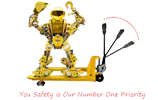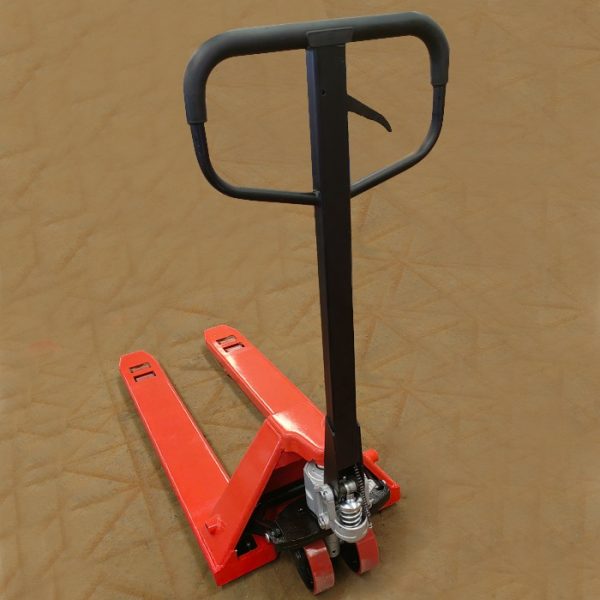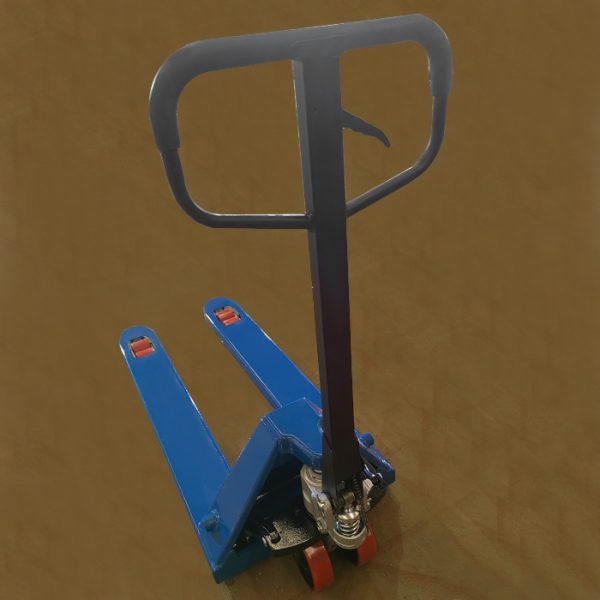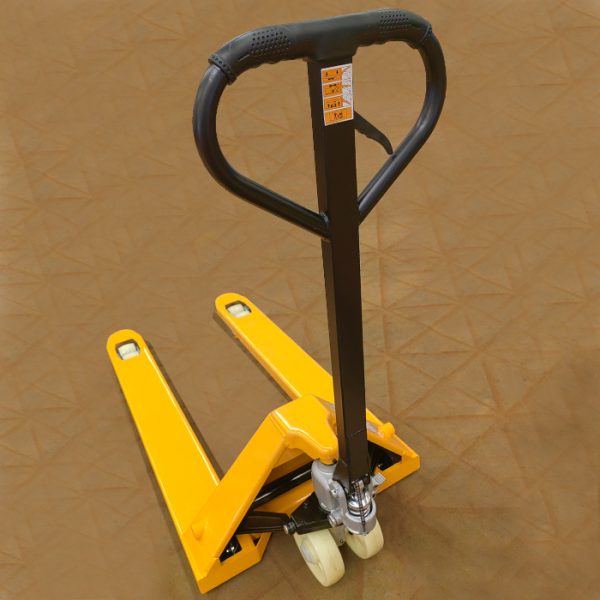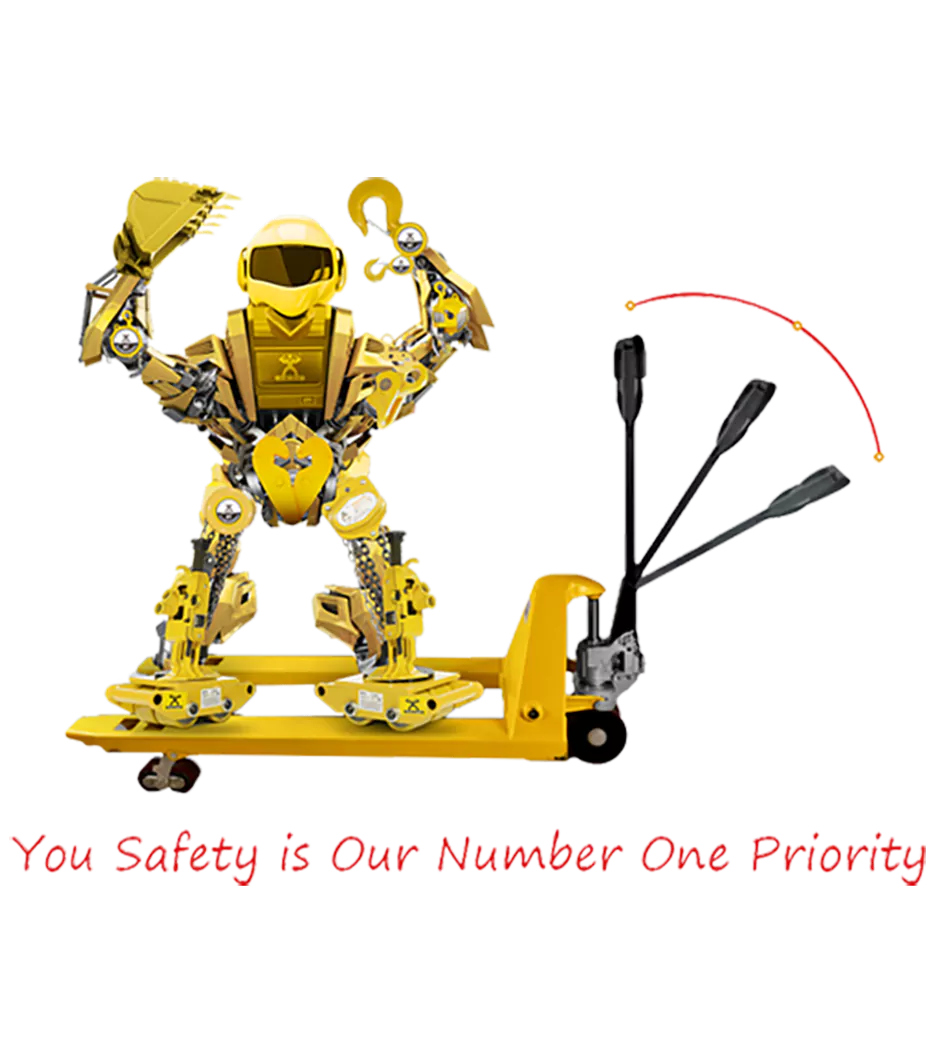In the bustling world of logistics and warehousing, the manual pallet truck stands as a cornerstone of efficient material handling. This unassuming piece of equipment, often overlooked, plays a pivotal role in streamlining operations, enhancing productivity, and ensuring safety in warehouses and distribution centers worldwide.
“The Essential Guide to Manual Pallet Trucks: Efficiency and Safety in Material Handling” delves into the heart of this indispensable tool, exploring its design, functionality, and the myriad benefits it brings to various industries. Whether you’re a seasoned warehouse manager or new to the field, understanding the nuances of manual pallet trucks can significantly boost your operational efficiency and safety standards.
Join us as we navigate through the features, applications, and best practices that make the manual pallet truck an invaluable asset in the material handling arsenal.
What is a Manual Pallet Truck?
A manual pallet truck, often referred to as a pallet jack or pump truck, is a hand-operated tool used to lift and move pallets within a warehouse, factory, retail store, or other storage facilities. It consists of a pair of forks designed to slide under a pallet, a hydraulic jack to lift the pallet off the ground, and wheels to facilitate movement.
Operators use a handle to steer and pump the hydraulic system, raising and lowering the forks to transport goods with ease. Manual pallet trucks are renowned for their simplicity, efficiency, and ability to handle heavy loads with minimal effort, making them a staple in material handling operations.
History and Evolution of Manual Pallet Trucks:
The history of the manual pallet truck dates back to the early 20th century, paralleling the rise of mass production and the need for more efficient material handling solutions. The first rudimentary versions of pallet trucks emerged in the 1920s, featuring basic lifting mechanisms and limited maneuverability. These early models were instrumental in revolutionizing the logistics industry, providing a practical solution for moving heavy loads without relying solely on manual labor.
As industrialization progressed, so did the design and functionality of pallet trucks. By the mid-20th century, improvements in hydraulic technology led to the development of more advanced and efficient models. These innovations included stronger materials, better wheels, and enhanced hydraulic systems, which increased load capacities and ease of use. The introduction of the modern manual pallet truck, with its characteristic ergonomic handle and durable construction, marked a significant leap forward in material handling efficiency.
Over the decades, manufacturers have continued to refine the design of manual pallet trucks, incorporating features such as low-profile forks for handling lower pallets, specialized wheels for different floor surfaces, and even integrated weighing scales for on-the-spot load measurements. Despite the advent of powered pallet jacks and forklifts, the manual pallet truck remains a popular choice due to its cost-effectiveness, simplicity, and versatility.
Today, the manual pallet truck is an indispensable tool in various industries, embodying a perfect blend of historical ingenuity and modern innovation. Its evolution reflects the ongoing quest for improved efficiency and safety in material handling, cementing its role as a fundamental component of warehouse operations worldwide.
Types of Manual Pallet Trucks:
Manual pallet trucks for sale come in various types, each designed to meet specific needs and applications. Understanding the differences among these types can help businesses choose the most suitable option for their material handling requirements.
1. Standard Manual Pallet Trucks:
Standard manual pallet trucks are the most commonly used type. They feature a straightforward design with a pair of forks that slide under a pallet and a hydraulic pump to lift and move the load. These trucks typically have a load capacity ranging from 2,000 to 5,500 pounds and are ideal for general-purpose use in warehouses, retail stores, and other environments where pallets need to be transported over short distances.
Key Features:
1.Standard fork dimensions (27 inches wide by 48 inches long)
2.Ergonomic handle for easy maneuvering
3.Durable construction for long-lasting use
2. Low Profile Manual Pallet Trucks
Low profile manual pallet trucks are designed to handle pallets and skids that sit lower to the ground than standard pallets. These trucks have a reduced fork height, allowing them to fit into tight spaces and lift low-clearance loads effectively.
Key Features:
1.Fork heights as low as 1.75 inches
2.Suitable for handling special low-profile pallets
3.Ideal for environments with low-clearance requirements
3. Wide and Narrow Manual Pallet Trucks
Wide and narrow manual pallet trucks cater to pallets and loads that are either wider or narrower than standard sizes. Wide pallet trucks are used for handling oversized pallets, while narrow pallet trucks are perfect for navigating tight aisles and handling smaller loads.
Key Features:
1.Custom fork widths to accommodate specific pallet sizes
2.Enhanced maneuverability in confined spaces (narrow trucks)
3.Increased stability for larger loads (wide trucks)
4. Specialty Manual Pallet Trucks
Specialty manual pallet trucks are designed for specific applications, offering unique features that address particular material handling needs.
High-Lift Pallet Trucks:
1.Capable of lifting loads to greater heights (up to 31 inches)
2.Often used for stacking pallets or lifting loads to workbench height
3.Typically feature stabilizing legs for added safety
Galvanized Pallet Trucks:
1.Constructed with galvanized steel for corrosion resistance
2.Ideal for use in wet or corrosive environments, such as food processing or outdoor applications
Weigh Scale Pallet Trucks:
1.Integrated weighing scales for on-the-spot load measurements
2.Allow operators to weigh and transport pallets simultaneously
3.Useful for shipping and receiving, inventory control, and quality assurance
By choosing the appropriate type of manual pallet truck, businesses can optimize their material handling processes, improve efficiency, and enhance workplace safety. Each type offers distinct advantages, ensuring that there is a manual pallet truck suitable for virtually any application.
Key Components and Features:
Understanding the key components and features of manual pallet trucks is crucial for their effective use and maintenance. Each part plays a significant role in the overall functionality and efficiency of the truck.
1. Forks
The forks are the two long, horizontal arms that extend from the front of the pallet truck. They are designed to slide under a pallet and lift it off the ground.
Key Features:
1.Standard Size: Typically 27 inches wide and 48 inches long, suitable for standard pallets.
2.Low Profile: Forks can be as low as 1.75 inches for handling low-clearance pallets.
3.Durability: Made from high-strength steel to withstand heavy loads.
2. Hydraulic Pump
The hydraulic pump is the heart of the manual pallet truck, enabling the lifting and lowering of the forks. It operates by converting manual pumping action into hydraulic pressure.
Key Features:
1.Efficiency: Provides smooth and effortless lifting with minimal manual effort.
2.Reliability: Built to last with high-quality seals and robust construction.
3.Maintenance: Generally requires minimal maintenance but should be checked regularly for leaks and proper fluid levels.
3. Steering Handle
The steering handle is used to maneuver the pallet truck and control the lifting and lowering of the forks. It is designed to provide ergonomic handling and ease of use.
Key Features:
1.Ergonomic Design: Comfortable grip to reduce operator fatigue.
2.Control Levers: Integrated levers for lifting, lowering, and neutral positions.
3.Rotation: Often allows up to 200 degrees of rotation for better maneuverability in tight spaces.
4. Wheels and Rollers
Wheels and rollers are essential for the mobility and stability of the pallet truck. They come in various materials and designs to suit different floor surfaces and operational environments.
Key Features:
1.Load Wheels: Located at the front, beneath the forks, they support the load during transport.
2.Steering Wheels: Located at the base of the handle, they enable steering and maneuverability.
3.Material: Options include nylon (for smooth surfaces), polyurethane (for quiet and smooth operation), and rubber (for better grip and shock absorption).
5. Load Capacity
The load capacity of a manual pallet truck indicates the maximum weight it can safely lift and transport. It is a critical factor to consider when selecting a pallet truck for specific applications.
Key Features:
1.Standard Capacity: Typically ranges from 2,000 to 5,500 pounds, suitable for most general-purpose applications.
2.Heavy-Duty Options: Available for specialized applications requiring higher load capacities.
3.Safety: Exceeding the load capacity can lead to equipment failure and safety hazards, so it’s important to adhere to the manufacturer’s specifications.
By understanding these key components and features, operators can ensure they are using the manual pallet truck effectively and safely. Proper knowledge of each part’s function and maintenance requirements contributes to the longevity and optimal performance of the equipment, enhancing overall efficiency in material handling operations.
Conclusion
Manual pallet trucks are indispensable tools in any efficient material handling operation, offering simplicity, versatility, and reliability. By understanding the different types of manual pallet trucks and their key components and features, businesses can make informed decisions to enhance their logistics processes.
Whether you need a standard pallet truck for general use or a specialized model for specific applications, selecting the right equipment is crucial for optimizing productivity and ensuring workplace safety.
If you’re looking to purchase a manual pallet truck from a reputable and professional company, consider contacting Gonyougroup. With their extensive range of high-quality pallet trucks and commitment to customer satisfaction, Gonyougroup is well-equipped to meet your material handling needs. Contact us today to find the perfect manual pallet truck for your business.
